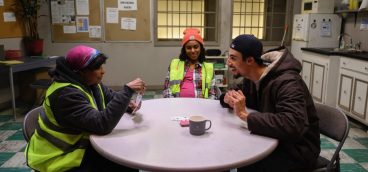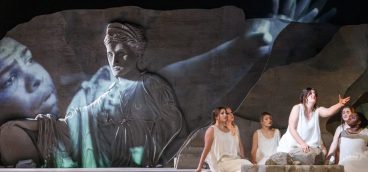The Fine Collection Follows and Augments a Long Line of Pittsburgh Benefactors

Andrew Carnegie provided the means to establish the Carnegie Institute, but he believed that it should be supported by those who use it. He wasn’t much of an art collector, so he left it to others to buy or give the grand building’s objects. The art museum’s collection grew very slowly at first, with purchases from the Carnegie Internationals, as suggested by the founder himself, and a few donations. Later gifts helped put it on the map.
Mellon family members have been influential patrons, enhancing the permanent collection and providing funds for acquisitions and operations that still exist today. Two donated family collections stand out.
The Scaife family funded the Carnegie’s new wing in 1974, doubling the square footage for art. Sarah Mellon Scaife, with her son Richard and the museum’s director Leon Arkus, already had been buying for the museum, assembling a top-notch collection of impressionist and post-impressionist works that would become the anchors of the museum. Monet’s Water Lilies, Bonnard’s Nude in a Bathtub, and Matisse’s The One Thousand and One Nights remain critical highlights and fan favorites.
Ailsa Mellon Bruce purchased 18th-century English antiques and other decorative arts objects for her homes and, in 1970, bequeathed them to the Carnegie for the decorative arts galleries named for her. She followed in the footsteps of her father and grandfather in giving her French paintings to the National Gallery but gave 2,800 objects to Pittsburgh.

Carnegie Museum of Art, Pittsburgh (November 18, 2023 – March 17, 2024), featuring three takes on the human figure in sculptures by Matthew Monahan (foreground), Anne Chu (left), and Judith Shea (right).
These hometown gifts are the best-known donations, but several others have shaped the museum’s collection. U.S. Steel executive James Austin fell in love with Japan and started collecting Japanese prints, giving more than 2,600 to the museum, creating an important collection. But not all stories about Pittsburgh collections end so well.
When I moved to Pittsburgh in the early 1980s, I kept hearing “Pittsburgh-born” attached to the name of anyone famous, such as Martha Graham and Andy Warhol, who were born here but moved elsewhere. There was a parallel with art collections. Washington, D.C. not only received treasures from the Mellon family for the National Gallery, but also from Pittsburgh-born Duncan Phillips, who left for D.C. at the age of 9 or 10. He assembled one of the best collections of modern art, purchasing over 2,500 works and opening his own museum in 1921. The Phillips Collection remains a significant addition to the nation’s capital, but here it is seen as one that got away, even though his ties to the city were slight.
Another collection that got away was that of investment banker and industrialist G. David Thompson who courted, and was courted by, the Carnegie for years. Negotiations failed over many disagreements about price, where the collection would reside — the Carnegie, Carnegie Mellon University, Thompson’s house — and several other, ever-changing issues. The process generated plenty of rumors and left all parties dissatisfied. Thompson dispersed his collection with gifts of major works by established artists such as Picasso to the Museum of Modern Art and Motherwell, Kline, and Moore to the Fogg Art Museum at Harvard in memory of his son. Much of the rest was sold at high prices and thus redistributed, many ending up in Europe.
The Carnegie lost out on many great works, but Thompson strengthened the collection with 66 paintings and sculptures between 1928 and 1964. After his death, Alcoa bought 75 works from his estate and gifted several to the museum, which purchased only one work. Key works including the Henry Moore Reclining Nude now in front of the museum and the brilliant Woman by de Kooning are associated with Thompson. He was also instrumental in placing the Calder mobile from the 1958 International at the Pittsburgh airport.

above left: Installation view of The Milton and Sheila Fine Collection with paintings by Chris Ofili titled The Adoration of Captain Shit and the Legend of the Black Stars (Third Version), above right: Untitled of 1987, by Sigmar Polke. Both are from the 1999 Carnegie International purchased by the Fines.
Milton and Sheila Fine and their collection are now part of this history. They became consummate museum patrons and exemplary partners who had a long and symbiotic relationship with the museum. Milton’s involvement with the Carnegie Museum of Art was jump-started when he met Director John Lane and his International curator/colleague John Caldwell in the 1980s. He soon started collecting museum-quality work, following a first, impulsive buy of a painting in Paris in the ’70s, a work he later sold. With the museum in mind, he and Sheila assembled a contemporary art collection. He also became involved as a trustee at both art museums, chairing the art museum board from 1994 to 2000. The Fines announced their intention to give “a significant portion” of their collection to the Carnegie in 2015; 104 works of contemporary art were accessioned between 2020 and 2022, many of which will be integrated into the museum galleries. The collection is now on view as a special exhibition with a large catalog. Their generosity expanded to include production of the catalog and conservation of the collection.
Although the collection is the most visible aspect of their philanthropy at the museum, their support goes well beyond works of art and will have long-lasting effects. Many of their gifts are now funneled through The Fine Foundation, set up in 2007 to support arts and culture, science and medicine, and Jewish life, primarily in Pittsburgh. The seed money came from the sale of Milton’s hotel and real estate businesses.
The foundation has distributed more than $30 million, and the intent is to give away all the funds by 2031-33. In addition to the Carnegie, they provide grants for many smaller Pittsburgh arts organizations. They made a connection with his alma mater, the University of Pittsburgh, funding Milton Fine Professional Fellowships and supporting a curatorial studies component in the History of Art and Architecture in the 2010s. This, too, was meant as an investment in the future.
The Carnegie Museum of Art remained a favored institution for the Fines. Generous donations established the Fine Prize for an emerging artist at the International, beginning in 2007, and funded the Milton Fine Curator of Art position at the Andy Warhol Museum. The art museum has received additional funds that supported organizing and educational costs for International exhibitions and acquisition funds.
I met Milton Fine, and later his wife Sheila, when I worked at the Carnegie Museum of Art. He was a presence at the museum as a trustee and a collector; I found him imposing and reserved but always kind, while Sheila had a lively and infectious personality. Hospitality at their large Fox Chapel home was generous, and it was always fun to explore their collection in that setting. A white box gallery allowed them to also rotate pieces in a museum-like setting in their home, while the Jeff Koons String of Puppies settled at the base of a staircase.
The two were always welcoming and friendly, but their deepest bond was with curators John Caldwell and Richard Armstrong, later director (1996-2008). These two were their friends and advisors, collaborating on selections and purchases and facilitating access to artists, dealers, and other collectors. Buying art is not as easy as most believe; dealers create hierarchies of potential buyers and control waiting lists for the work of hot artists. Knowing that a work is destined for an important museum opened doors for Milton and Sheila.
The Fine Collection was one of the larger holdings of contemporary art in Pittsburgh, always on the itinerary for interested visitors. Milton and Sheila pursued works, primarily at big-name galleries in the U.S. and Europe, that would complement and expand the museum’s contemporary collection. Following the lead of museum staff, they added works by artists, some already represented in the collection, and many from the Carnegie Internationals, continuing a tradition of collecting from the exhibition that has defined the museum.
For example, Sigmar Polke, a renowned German artist, showed in 1985, ’88, and ’95 and shared the prestigious Carnegie Prize in 1995 with sculptor Richard Artschwager. Polke continually changed his style and content. In 1985 he showed mesmerizing, photo-based paintings of watchtowers, structures with a troubling history in his native Germany. The museum bought an example from this series as part of its growing commitment to post-war German painting. Polke had made a name for himself already with a series of colorful pop pieces, influenced by the American movement, and the Fines acquired an example that is part of their gift. In addition, they purchased a later, double-sided painting related to what Polke showed in 1988. These additions enable the museum to exhibit the trajectory of a favored artist who captured the attention of both museum advisors.
Likewise, there is an untitled film still from Cindy Sherman’s acclaimed early series that shows the roots of two later larger, color photographs the museum owns, one of which came from the 1985 International. A drawing by Carnegie Prize winner William Kentridge goes with short films shown in 1999, now housed in the museum. A series of seascape photographs by Hiroshi Sugimoto that were exhibited outside in the sculpture court, sometimes coated with snow and ice, at the 1991 show, are also coming to the museum. The Fines added three photographs from the series to their own collection and provided funds for the museum to purchase an additional eight, combining a personal gift with an acquisition fund as sources for work.
Their fund became a resource for major museum purchases such as Bill Viola’s powerful Sleep of Reason video installation, Chris Ofili’s bedazzled and controversial figurative painting, and a multi-layered painting by successful Los Angeles artist Mark Bradford. All three were International stunners. These additions to the museum’s permanent collection continue a Carnegie practice of purchasing work for and from the Internationals, a tradition linked to Carnegie’s original proposal to collect the old masters of tomorrow but a habit that some see as a troubling conflation of the art market and museum validation.
This alignment of the interests of the collectors with the museum provides a starting point for understanding the Fine collection. Approximately half of the works in this collection are by artists included in the Internationals, so their work received the seal of approval from the museum.
Two trends followed the museum’s interests and became areas of concentration in the collection: minimalist and figurative art. The Sugimotos belong with related works that amplify the museum’s collection, including works on paper by Brice Marden and Richard Serra, sculptures by Sol LeWitt, Joel Shapiro, Eva Rothschild, and Meg Webster, furniture by Scott Burton, and a painting by Robert Mangold, not to mention works deeply indebted to minimalism. All artists except for Mangold and Webster were shown in Internationals, and Webster was featured in a Forum Gallery show in 1991.
Another strength of the Fine collection is figurative work. Three large-scale sculptures by Anne Chu, Judith Shea, and Matthew Monahan dominate this group. All speak of the human condition in different ways, and their “conversation” is the best part of the exhibition installation. All three have political overtones, reflecting the couple’s fascination with figurative work that “critiqued mass culture.” Broadening this interest, and perhaps the star of the entire collection, is the Jeff Koons String of Puppies, a sardonic take on sentimentality, kitsch, and popular culture. Once again, all artists except Shea have been featured in Internationals.
The Fine collection deserves a deeper dive. The museum has called it — and them — risky, prescient, discerning, intuitive, and adventuresome. The catalog provides a factual outline that will be filled in with more information and insights in the future on different platforms, hopefully similar to the Costas Karakatsanis article on G. David Thompson in the storyboard section of the museum’s website. The effect of their close relationship to the Carnegie — collector, patron, trustee — and especially their deep friendship with Caldwell and Armstrong is obvious. Their curatorial tastes and interests can be seen throughout, both in the works purchased by the collectors and kept in their home until now and in works the museum bought with funds supplied by the couple. The influence and emphasis on International-worthy artists kept the collection, for the most part, within the sphere of the museum’s collection.
The wall labels in the exhibition of their collection note the momentum gained in the 1980s when Caldwell curated the Internationals and the most works were purchased. Milton has stated that his collecting activities were catalyzed by the 1991 International, although only three artists from that show are in the Fine collection. The three decades of the 1980s, 1990s, and 2000s were the most active periods, with the acquisition of three-quarters of the work — when Caldwell and Armstrong worked at the museum.
The Fines’ close connection with the museum means that their additions fit nicely into the museum’s collection, but it also raises some questions. Does the reliance on already supported artists mean that their works will end up in storage and not on display? For example, does the museum need 10 works by Christopher Wool, three of which come from the Fines (two large paintings and a more modest drawing)? Will the museum consider selling any to raise funds to diversify its collection, as many museums have done recently, much to the consternation of their audiences?
Also, did the alliance of museum and collectors limit the range of works considered? Was the Fine’s attention directed toward the Internationals, with a resulting lost opportunity to add variety to the museum’s collection with artists outside the lines of its defining exhibition?
During this period, many art museums began a reassessment of voices they supported with increased visibility in the galleries and the collection; could work by those previously left out of history have been increased, allowing more people to see their experiences and creations on the walls, or is that asking too much? Perhaps the museum is paying attention to those lacunae. There are collections in town that include these artists and perhaps they will come to strengthen the museum in the future.
There are a few examples of these possibilities in the Fine collection. Alfredo Jaar is a well-received conceptual and politically oriented artist working in several photographic formats, and Arturo Herrera uses comic and cartoon imagery to address serious issues. Artists ranging from Kiki Smith, shown at the Mattress Factory, to the Starn Twins, art stars of the ’90s, will add flavor to the permanent collection. Makes me wish for more.
The exhibition and catalog at the Carnegie don’t really address how the Fines made their choices, so we are left to draw our own conclusions. What mattered and what appealed to Milton and/or Sheila? Was there a collection philosophy or strategy? The closest we come to a motivation is the Jewish practice of tikkun olam, which is a belief in repairing the world. It was a lived experience, a moral concept made real during Milton’s childhood that became an important motivation for his philanthropy.
He spoke about being “more interested in beginnings than in endings,” in “[making] things happen,” and “[building] things of significance.” Sheila talks about art that is “hard to talk about” and that “might make you uncomfortable,” qualities that reflect these values. Milton credited art with making him “more creative and more daring in every aspect of life. It has sharpened my sense of nuance, made me more comfortable with ambiguity, and allowed me to construct more imaginative solutions to problems.”
This resonates with Andrew Carnegie’s motives voiced at the 1895 dedication of the Carnegie Library of Pittsburgh: “Mine be it to have contributed to enlightenment and joys of the mind, to the things of the spirit, to all that tends to bring into the lives of the toilers of Pittsburgh sweetness and light.” These are both lofty and worthy ambitions for their gifts. pq
Vicky A. Clark is an independent curator and writer, involved in contemporary art and issues since the early 1980s in Pittsburgh.















